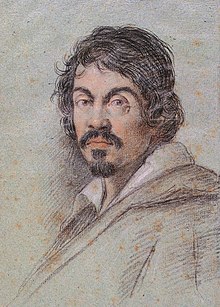Michelangelo Merisi da Caravaggio
| Caravaggio | |
|---|---|

Chalk portrait of Caravaggio by Ottavio Leoni, circa 1621.
|
|
| Born |
Michelangelo Merisi or Amerighi 29 September 1571 Milan, Duchy of Milan, Spanish Empire |
| Died | 18 July 1610 (aged 38) Porto Ercole, Grand Duchy of Tuscany |
| Known for | Painting |
| Notable work | See Chronology of works by Caravaggio |
| Movement | Baroque |
| Patron(s) | Cardinal Francesco Maria del Monte Alof de Wignacourt |
Michelangelo Merisi (Michele Angelo Merigi or Amerighi) da Caravaggio (Italian pronunciation: [karaˈvaddʒo]; 29 September 1571 – 18 July 1610) was an Italian painter active in Rome, Naples, Malta, and Sicily between 1592 (1595?) and 1610. His paintings, which combine a realistic observation of the human state, both physical and emotional, with a dramatic use of lighting, had a formative influence on Baroque painting.
Caravaggio trained as a painter in Milan under Simone Peterzano who had himself trained under Titian. In his twenties Caravaggio moved to Rome, where there was a demand for paintings to fill the many huge new churches and palazzos being built at the time. It was also a period when the Church was searching for a stylistic alternative to Mannerism in religious art that was tasked to counter the threat of Protestantism. Caravaggio's innovation was a radical naturalism that combined close physical observation with a dramatic, even theatrical, use of chiaroscuro which came to be known as tenebrism (the shift from light to dark with little intermediate value).
He gained attention in the art scene of Rome in 1600 with the success of his first public commissions, the Martyrdom of Saint Matthew and Calling of Saint Matthew. Thereafter he never lacked commissions or patrons, yet he handled his success poorly. He was jailed on several occasions, vandalized his own apartment, and ultimately had a death sentence pronounced against him by the Pope after killing a young man, possibly unintentionally, on May 29, 1606.
...
Wikipedia
